March 1997 lunar eclipse
Partial lunar eclipse March 24, 1997 From Wikipedia, the free encyclopedia
A partial lunar eclipse occurred at the Moon’s ascending node of orbit on Monday, March 24, 1997,[1] with an umbral magnitude of 0.9195. A lunar eclipse occurs when the Moon moves into the Earth's shadow, causing the Moon to be darkened. A partial lunar eclipse occurs when one part of the Moon is in the Earth's umbra, while the other part is in the Earth's penumbra. Unlike a solar eclipse, which can only be viewed from a relatively small area of the world, a lunar eclipse may be viewed from anywhere on the night side of Earth. Occurring about 3.2 days after apogee (on March 20, 1997, at 23:40 UTC), the Moon's apparent diameter was smaller.[2]
| Partial eclipse | |||||||||||||
 Partiality as viewed from Hayward, California at 4:45 UTC | |||||||||||||
| Date | March 24, 1997 | ||||||||||||
|---|---|---|---|---|---|---|---|---|---|---|---|---|---|
| Gamma | 0.4899 | ||||||||||||
| Magnitude | 0.9195 | ||||||||||||
| Saros cycle | 132 (29 of 71) | ||||||||||||
| Partiality | 203 minutes, 3 seconds | ||||||||||||
| Penumbral | 353 minutes, 54 seconds | ||||||||||||
| |||||||||||||
This lunar eclipse was the third of an almost tetrad, with the others being on April 4, 1996 (total); September 27, 1996 (total); and September 16, 1997 (total).
This was the last of the first set of partial eclipses in Lunar Saros 132.
Visibility
The eclipse was completely visible over much of North America and South America, seen rising over western North America and the central Pacific Ocean and setting over Africa, Europe, and west and central Asia.[3]
  |
Gallery
- Hayward, California, 5:00 UT
Eclipse details
Shown below is a table displaying details about this particular lunar eclipse. It describes various parameters pertaining to this eclipse.[4]
| Parameter | Value |
|---|---|
| Penumbral Magnitude | 1.99936 |
| Umbral Magnitude | 0.91953 |
| Gamma | 0.48990 |
| Sun Right Ascension | 00h13m09.7s |
| Sun Declination | +01°25'31.5" |
| Sun Semi-Diameter | 16'02.5" |
| Sun Equatorial Horizontal Parallax | 08.8" |
| Moon Right Ascension | 12h13m42.1s |
| Moon Declination | -01°00'04.5" |
| Moon Semi-Diameter | 14'51.3" |
| Moon Equatorial Horizontal Parallax | 0°54'31.3" |
| ΔT | 62.4 s |
Eclipse season
This eclipse is part of an eclipse season, a period, roughly every six months, when eclipses occur. Only two (or occasionally three) eclipse seasons occur each year, and each season lasts about 35 days and repeats just short of six months (173 days) later; thus two full eclipse seasons always occur each year. Either two or three eclipses happen each eclipse season. In the sequence below, each eclipse is separated by a fortnight.
| March 9 Descending node (new moon) | March 24 Ascending node (full moon) |
|---|---|
 |  |
| Total solar eclipse Solar Saros 120 | Partial lunar eclipse Lunar Saros 132 |
Related eclipses
Summarize
Perspective
Eclipses in 1997
- A total solar eclipse on March 9.
- A partial lunar eclipse on March 24.
- A partial solar eclipse on September 2.
- A total lunar eclipse on September 16.
Metonic
- Preceded by: Lunar eclipse of June 4, 1993
- Followed by: Lunar eclipse of January 9, 2001
Tzolkinex
- Preceded by: Lunar eclipse of February 9, 1990
- Followed by: Lunar eclipse of May 4, 2004
Half-Saros
- Preceded by: Solar eclipse of March 18, 1988
- Followed by: Solar eclipse of March 29, 2006
Tritos
- Preceded by: Lunar eclipse of April 24, 1986
- Followed by: Lunar eclipse of February 21, 2008
Lunar Saros 132
- Preceded by: Lunar eclipse of March 13, 1979
- Followed by: Lunar eclipse of April 4, 2015
Inex
- Preceded by: Lunar eclipse of April 13, 1968
- Followed by: Lunar eclipse of March 3, 2026
Triad
- Preceded by: Lunar eclipse of May 24, 1910
- Followed by: Lunar eclipse of January 22, 2084
Lunar eclipses of 1995–1998
This eclipse is a member of a semester series. An eclipse in a semester series of lunar eclipses repeats approximately every 177 days and 4 hours (a semester) at alternating nodes of the Moon's orbit.[5]
The penumbral lunar eclipse on August 8, 1998 occurs in the next lunar year eclipse set.
| Lunar eclipse series sets from 1995 to 1998 | ||||||||
|---|---|---|---|---|---|---|---|---|
| Ascending node | Descending node | |||||||
| Saros | Date Viewing |
Type Chart |
Gamma | Saros | Date Viewing |
Type Chart |
Gamma | |
| 112 | 1995 Apr 15 |
Partial |
−0.9594 | 117 | 1995 Oct 08 |
Penumbral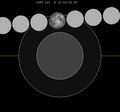 |
1.1179 | |
122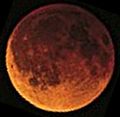 |
1996 Apr 04 |
Total |
−0.2534 | 127 |
1996 Sep 27 |
Total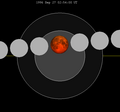 |
0.3426 | |
132 |
1997 Mar 24 |
Partial |
0.4899 | 137 | 1997 Sep 16 |
Total |
−0.3768 | |
| 142 | 1998 Mar 13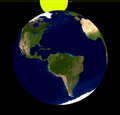 |
Penumbral |
1.1964 | 147 | 1998 Sep 06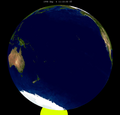 |
Penumbral |
−1.1058 | |
Saros 132
This eclipse is a part of Saros series 132, repeating every 18 years, 11 days, and containing 71 events. The series started with a penumbral lunar eclipse on May 12, 1492. It contains partial eclipses from August 16, 1636 through March 24, 1997; total eclipses from April 4, 2015 through August 2, 2213; and a second set of partial eclipses from August 13, 2231 through November 30, 2411. The series ends at member 71 as a penumbral eclipse on June 26, 2754.
The longest duration of totality will be produced by member 36 at 106 minutes, 6 seconds on June 9, 2123. All eclipses in this series occur at the Moon’s ascending node of orbit.[6]
| Greatest | First | |||
|---|---|---|---|---|
 The greatest eclipse of the series will occur on 2123 Jun 09, lasting 106 minutes, 6 seconds.[7] |
Penumbral | Partial | Total | Central |
1492 May 12 |
1636 Aug 16 |
2015 Apr 04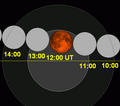 |
2069 May 06 | |
| Last | ||||
| Central | Total | Partial | Penumbral | |
2177 Jul 11 |
2213 Aug 02 |
2411 Nov 30 |
2754 Jun 26 | |
Eclipses are tabulated in three columns; every third eclipse in the same column is one exeligmos apart, so they all cast shadows over approximately the same parts of the Earth.
| Series members 19–40 occur between 1801 and 2200: | |||||
|---|---|---|---|---|---|
| 19 | 20 | 21 | |||
| 1816 Dec 04 | 1834 Dec 16 | 1852 Dec 26 | |||
| 22 | 23 | 24 | |||
| 1871 Jan 06 | 1889 Jan 17 | 1907 Jan 29 | |||
 |
 | ||||
| 25 | 26 | 27 | |||
| 1925 Feb 08 | 1943 Feb 20 | 1961 Mar 02 | |||
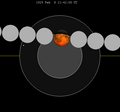 |
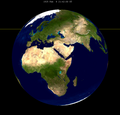 |
 |
 |
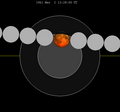 |
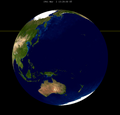 |
| 28 | 29 | 30 | |||
| 1979 Mar 13 | 1997 Mar 24 | 2015 Apr 04 | |||
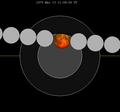 |
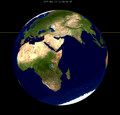 |
 |
 |
 |
 |
| 31 | 32 | 33 | |||
| 2033 Apr 14 | 2051 Apr 26 | 2069 May 06 | |||
 |
 |
 |
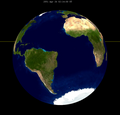 |
 |
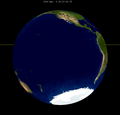 |
| 34 | 35 | 36 | |||
| 2087 May 17 | 2105 May 28 | 2123 Jun 09 | |||
 |
 |
 |
|||
| 37 | 38 | 39 | |||
| 2141 Jun 19 | 2159 Jun 30 | 2177 Jul 11 | |||
| 40 | |||||
| 2195 Jul 22 | |||||
Tritos series
This eclipse is a part of a tritos cycle, repeating at alternating nodes every 135 synodic months (≈ 3986.63 days, or 11 years minus 1 month). Their appearance and longitude are irregular due to a lack of synchronization with the anomalistic month (period of perigee), but groupings of 3 tritos cycles (≈ 33 years minus 3 months) come close (≈ 434.044 anomalistic months), so eclipses are similar in these groupings.
| Series members between 1801 and 2200 | |||||||||
|---|---|---|---|---|---|---|---|---|---|
| 1811 Sep 02 (Saros 115) |
1822 Aug 03 (Saros 116) |
1833 Jul 02 (Saros 117) |
1844 May 31 (Saros 118) |
1855 May 02 (Saros 119) | |||||
| 1866 Mar 31 (Saros 120) |
1877 Feb 27 (Saros 121) |
1888 Jan 28 (Saros 122) |
1898 Dec 27 (Saros 123) |
1909 Nov 27 (Saros 124) | |||||
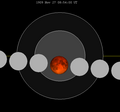 |
 | ||||||||
| 1920 Oct 27 (Saros 125) |
1931 Sep 26 (Saros 126) |
1942 Aug 26 (Saros 127) |
1953 Jul 26 (Saros 128) |
1964 Jun 25 (Saros 129) | |||||
 |
 |
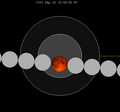 |
 |
 |
 |
 |
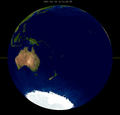 |
 |
 |
| 1975 May 25 (Saros 130) |
1986 Apr 24 (Saros 131) |
1997 Mar 24 (Saros 132) |
2008 Feb 21 (Saros 133) |
2019 Jan 21 (Saros 134) | |||||
 |
 |
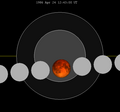 |
 |
 |
 |
 |
 |
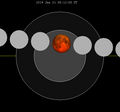 |
 |
| 2029 Dec 20 (Saros 135) |
2040 Nov 18 (Saros 136) |
2051 Oct 19 (Saros 137) |
2062 Sep 18 (Saros 138) |
2073 Aug 17 (Saros 139) | |||||
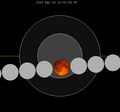 |
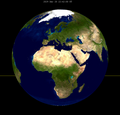 |
 |
 |
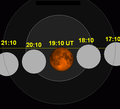 |
 |
||||
| 2084 Jul 17 (Saros 140) |
2095 Jun 17 (Saros 141) |
2106 May 17 (Saros 142) |
2117 Apr 16 (Saros 143) |
2128 Mar 16 (Saros 144) | |||||
| 2139 Feb 13 (Saros 145) |
2150 Jan 13 (Saros 146) |
2160 Dec 13 (Saros 147) |
2171 Nov 12 (Saros 148) |
2182 Oct 11 (Saros 149) | |||||
| 2193 Sep 11 (Saros 150) | |||||||||
Inex series
This eclipse is a part of the long period inex cycle, repeating at alternating nodes, every 358 synodic months (≈ 10,571.95 days, or 29 years minus 20 days). Their appearance and longitude are irregular due to a lack of synchronization with the anomalistic month (period of perigee). However, groupings of 3 inex cycles (≈ 87 years minus 2 months) comes close (≈ 1,151.02 anomalistic months), so eclipses are similar in these groupings.
| Series members between 1801 and 2200 | |||||
|---|---|---|---|---|---|
| 1823 Jul 23 (Saros 126) |
1852 Jul 01 (Saros 127) |
1881 Jun 12 (Saros 128) | |||
| 1910 May 24 (Saros 129) |
1939 May 03 (Saros 130) |
1968 Apr 13 (Saros 131) | |||
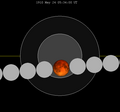 |
 |
 |
 |
 |
 |
| 1997 Mar 24 (Saros 132) |
2026 Mar 03 (Saros 133) |
2055 Feb 11 (Saros 134) | |||
 |
 |
 |
 |
 |
 |
| 2084 Jan 22 (Saros 135) |
2113 Jan 02 (Saros 136) |
2141 Dec 13 (Saros 137) | |||
 |
 |
||||
| 2170 Nov 23 (Saros 138) |
2199 Nov 02 (Saros 139) | ||||
Half-Saros cycle
A lunar eclipse will be preceded and followed by solar eclipses by 9 years and 5.5 days (a half saros).[8] This lunar eclipse is related to two total solar eclipses of Solar Saros 139.
| March 18, 1988 | March 29, 2006 |
|---|---|
 |
 |
See also
Notes
External links
Wikiwand - on
Seamless Wikipedia browsing. On steroids.

